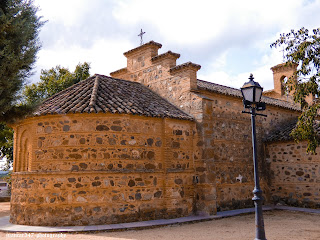Guadamur: cuando la Historia supera a la ficción / Guadamur: when history surpasses fiction
Situado en un punto estratégico de esos emblemáticos Montes de Toledo, custodios de innumerables misterios, poco o nada conocidos por esa metafórica madrastra en que suele convertirse una Historia, cuyos lodos no terminan, todavía, de sacar a relucir un contenido sumamente rico en aspectos culturales, un pueblo notable, Guadamur, observa la vida pasar, como esa entrañable poesía de Verlaine, siempre a la vera de un castillo, que, no en vano, merece el calificativo de ‘película’, puesto, que, por su belleza, elegancia y estado de conservación, ha sido elegido como escenario cinematográfico en multitud de ocasiones: desde buena parte de los episodios que conforman la popular serie, ‘Águila Roja’, hasta esas espeluznantes historias de terror, protagonizadas por nuestro internacional actor del género, Jacinto Molina, donde seres dantescos, como vampiros y hombres-lobo, se aúnan a unas mitologías, las vetonas y carpetanas, donde lo sobrenatural recibía también su culto, quedando sujetos, con el paso del tiempo, a las mercenarias necesidades de leyendas y tradiciones.
De alguna manera, si no sobrenatural, sí, al menos, casuísticamente fantástica, podría considerarse el descubrimiento, en 1858, de uno de los tesoros más soberbios de aquella fabulosa, casi desconocida y sobre todo, desgraciada España visigoda, que, cual una comparativa Atlántida platónica, quedó eternamente sumergida por el incontenible tsunami de la invasión musulmana del siglo VII, cuando las fuertes lluvias que cayeron en la región, dejaron al descubierto la maravillosa riqueza del denominado tesoro de Guarrazar, formado, en su mayoría, por una ingente cantidad de coronas votivas, de oro puro y aderezadas con singulares piedras preciosas, de los reyes visigodos y cuya historia, rocambolesca, donde las haya, terminó en disputas entre la astuta Francia y una indolente España, que nunca supo apreciar el valor intrínseco de su increíble Patrimonio Cultural. Réplicas de esas fabulosas coronas visigodas, no sólo se localizan en el pequeño museo de la localidad -algunas de las originales, se pueden contemplar en el Museo Arqueológico Nacional de Madrid- sino también, en otra de las singulares joyas patrimoniales de este pueblo afortunado, como es, no cabe duda, su elegante recinto sacro, de notable arquitectura mudéjar, que sirve de cobijo y continente para la que, a todas luces, pudo ser otra de las singulares y milagrosas Vírgenes Negras de España: la de la Natividad.
Located in
a strategic point of those emblematic Mounts of Toledo, custodians of
innumerable mysteries, little or nothing known by that metaphorical stepmother
that a History usually becomes, whose muds have not yet finished bringing to
light an extremely rich content in cultural aspects. , a remarkable town,
Guadamur, watches life go by, like that endearing poetry of Verlaine, always on
the side of a castle, which, not in vain, deserves the description of 'film',
since, due to its beauty, elegance and state of conservation, it has been
chosen as a film setting on many occasions: from many of the episodes that make
up the popular series, ‘Red Eagle', to those spooky horror stories, starring
our international actor of the genre, Jacinto Molina , where Dantesque beings,
such as vampires and werewolves, join some mythologies, the Vetonas and
Carpetanas, where the supernatural also received its cult, becoming subject,
with the passage of time, to the mercenary needs of legends and traditions.
In some
way, if not supernatural, yes, at least, casuistically fantastic, the
discovery, in 1858, of one of the most superb treasures of that fabulous,
almost unknown and, above all, unfortunate Visigothic Spain, could be
considered, which, like a comparative Platonic Atlantis was eternally submerged
by the uncontrollable tsunami of the Muslim invasion of the 7th century, when
the heavy rains that fell in the region revealed the wonderful wealth of the
so-called treasure of Guarrazar, formed, for the most part, by an enormous
amount of votive crowns, of pure gold and decorated with singular precious
stones, of the Visigoth kings and whose history, bizarre, if ever there was
one, ended in disputes between the astute France and an indolent Spain, which
never knew how to appreciate the intrinsic value of its incredible Cultural
heritage. Replicas of those fabulous Visigothic crowns are not only located in
the small museum of the town - some of the originals can be seen in the
National Archaeological Museum of Madrid - but also, in another of the unique
heritage jewels of this fortunate town, as is, without a doubt, its elegant
sacred enclosure, with notable Mudejar architecture, which serves as shelter
and continent for what, clearly, could have been another of the singular and
miraculous Black Virgins of Spain: that of the Nativity.
AVISO: Tanto el texto, como las fotografías que lo
acompañan, son de mi exclusiva propiedad intelectual y por lo tanto, están
sujetos a mis Derechos de Autor.
NOTICE:
Both the text and the accompanying photographs are my exclusive intellectual
property and are therefore subject to my Copyright.









Comentarios